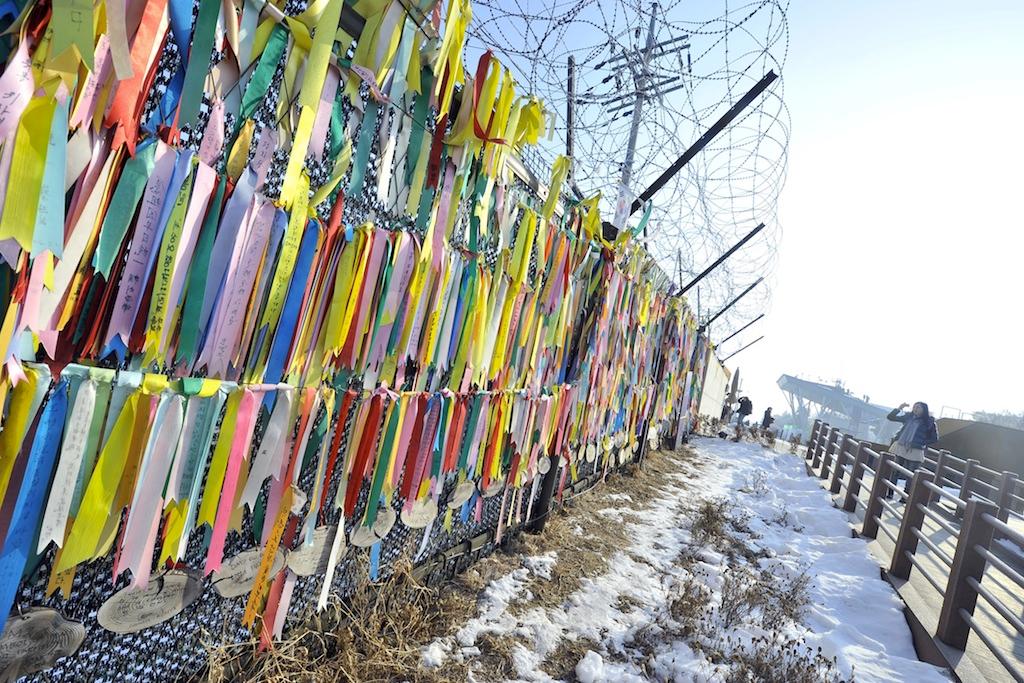Obituary: Korea’s unification movement (1998-2013)
A visitor looks at ‘reunification ribbons’ displayed on a military iron fence at Imjingak peace park in Paju near the demilitarized zone dividing the two Koreas on Feb. 13, 2013.
SEOUL, South Korea — Now that North Korea has recalled its workers from the Kaesong Industrial Zone — an area north of the DMZ where hundreds of South Korean managers oversee 51,000 North Korean laborers — it's farewell to hope for a peaceful unification, at least for now.
(Leonid Petrov is a Korea expert at Australian National University in Canberra.)
In the late 1990s, the peninsula was on a path towards reconciliation, and possibly unification into a single Korea. Diplomats and reporters were optimistic, pointing out that North Korea had been through a famine that left 1 million dead, and that the communist government could not maintain the status quo.
Proponents called the movement the "Sunshine Policy." The Kaesong Industrial Zone, opened in 2004, was the offspring of that movement — a model for the cooperation that would come.
"Sunshine" reached its height when the South Korean president, Kim Dae-jung, who later won the Nobel peace prize, met his dictatorial counterpart, Kim Jong Il, for a historic summit in Pyongyang. People called him the Asian version of Nelson Mandela.
But critics said any hope for real progress was naive, and that North Korea was playing with Seoul to get aid and concessions that would enrich the regime. Were they right?
In 2008, the conservative South Korean President Lee Myung-bak took office, ending many aid packages and gestures to its northern foe. North Korea was irate, and has since tested two nuclear bombs and launched two artillery and naval attacks off the West Coast of South Korea. Sad times for countries that once thought they could become one.
Today, the situation fell to a new low with the hermit state's unprecedented decision to remove its workers from Kaesong. The move comes after North Korea announced last week that it was blocking access to the South Koreans who work there.
More from GlobalPost: South Korea walks back on claims North is preparing missile test
After the world didn't take the decision seriously, the leaders got angry and, through state-run mouthpieces, criticized the South for its insistence that North Korea needed the Kaesong revenues. North Korea is too strong for that, they said.
Perhaps North Korea is just trying to make a petty point that it doesn't need the estate. Or perhaps it's trying to back up its threatening words over the past month.
For the past few hours, many North Korea watchers here in Seoul have been asking: Will there be a Sunshine 2.0? Is it possible that Pyongyang, with its rhetoric and poor economy, will dig itself so far into a hole that South Korea, once again, will attempt to pull it out?
Of course, the future of the isolated state is largely a guessing game. Ask any of the pundits who've been predicting a collapse since the end of the Cold War. But the agreement here is, for the most part, that "Sunshine" is obsolete.
So, farewell Sunshine, and goodbye to the once-loved but divisive legacy of Kim Dae-jung.
Every day, reporters and producers at The World are hard at work bringing you human-centered news from across the globe. But we can’t do it without you. We need your support to ensure we can continue this work for another year.
Make a gift today, and you’ll help us unlock a matching gift of $67,000!
